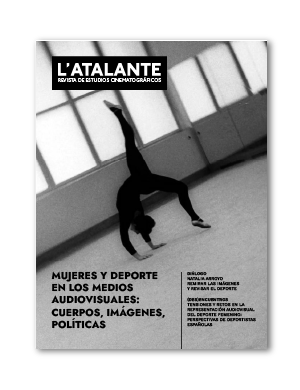Humanism, landscape and the sequence-shot in Béla Tarr’s Sátántangó
Publicades 2024-01-31
Paraules clau
- Sequence-shot,
- Béla Tarr,
- slow cinema,
- Hungarian cinema,
- fim narrative
- film analysis. ...Més
Com citar
Drets d'autor (c) 2024 L'Atalante. Revista d' estudis cinematogràfics

Aquesta obra està sota una llicència internacional Creative Commons Reconeixement-NoComercial-SenseObraDerivada 4.0.
Resum
Béla Tarr’s Sátántangó (1994) has been been studied from an aesthetic, political and philosophical perspective, but not from what Tarr and Krasznahorkai consider to be the most important element of their work: the representation of the human condition and dignity. This paper explores how Tarr uses the sequence-shot to represent the dignity of his characters in Sátántangó. Is it possible to identify a specific stylistic pattern in his representation of the human condition? How does Tarr approach the staging of the long take to represent a point of view of humanity? What kind of relationships Tarr establishes between scenarios and characters through camera movement and composition? How do these conceptual relationships contribute to presenting a point of view of the human condition?
Descàrregues
Referències
- Batori, A. (2018). Space in Romanian and Hungarian Cinema. Cham: Palgrave Macmillan.
- De Luca, T. (2015). Slow Cinema. Edinburgh: Edinburgh University Press.
- Luca, T., Jorge, N. (eds.) (2016). Slow Cinema (Traditions in World Cinema). Edinburgh: Edinburgh University Press.
- Finn, H. (2022). Cinematic Modernism and Contemporary Film. Aesthetics and Narrative in the International Art Film. London: Bloomsbury Publishing.
- Fisher, M. (2016). Realismo capitalista. Não haverá alternativa? Lisboa: VS.
- Heck, K. (2020). After Authority: Global Art Cinema and Political Transition. New Brunswick: Rutgers University Press.
- Hidalgo, A. (2013). La materialidad del encuentro. Los caminos de Sátántango. En Manrique, M. A. (ed.), Béla Tarr ¿Qué hiciste mientras esperabas? Santander: Shangrila.
- Jaffe, I., (2014). Slow Movies: Countering the Cinema of Action. London & New York: Wallflower Press.
- Kovács, A. (2013). The Cinema of Bèla Tarr – The Circle Closes. New York: Columbia University Press.
- Krasznahorkai, L. (2018). O tango de Satanás. Lisboa: Antígona.
- Maury, C., Rollet, S. (2016). Bèla Tarr – De La Colère au Tourment. Crisnée: Éditions Yellow Now.
- Rancière, J. (2013). Bèla Tarr – O Tempo do Depois. Lisboa: Orfeu Negro.
- Samardzija, Z. (2020). Post-Communist Malaise. In Post-Communist Malaise. New Brunswick: Rutgers University Press.
- Xavier, I., Cinematográfico, O. D. (2008). A opacidade e a transparência. São Paulo: Paz e Terra.
- Yurchak, A. (2013). Everything Was Forever, Until it Was No More. Princeton: Princeton University Press.

